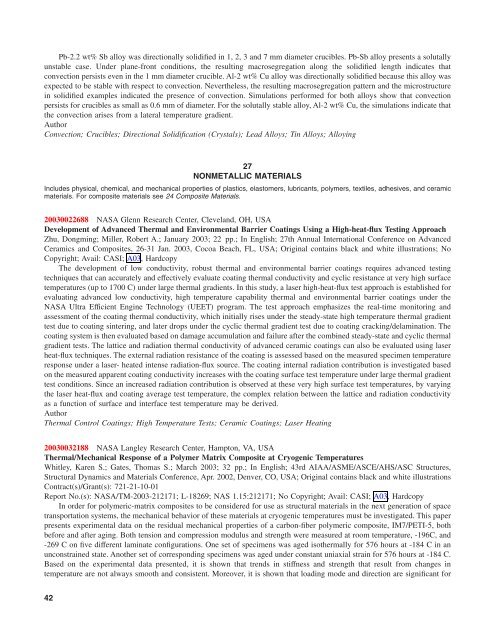Create successful ePaper yourself
Turn your PDF publications into a flip-book with our unique Google optimized e-Paper software.
Pb-2.2 wt% Sb alloy was directionally solidified in 1, 2, 3 and 7 mm diameter crucibles. Pb-Sb alloy presents a solutally<br />
unstable case. Under plane-front conditions, the resulting macrosegregation along the solidified length indicates that<br />
convection persists even in the 1 mm diameter crucible. Al-2 wt% Cu alloy was directionally solidified because this alloy was<br />
expected to be stable with respect to convection. Nevertheless, the resulting macrosegregation pattern and the microstructure<br />
in solidified examples indicated the presence of convection. Simulations performed for both alloys show that convection<br />
persists for crucibles as small as 0.6 mm of diameter. For the solutally stable alloy, Al-2 wt% Cu, the simulations indicate that<br />
the convection arises from a lateral temperature gradient.<br />
Author<br />
Convection; Crucibles; Directional Solidification (Crystals); Lead Alloys; Tin Alloys; Alloying<br />
27<br />
NONMETALLIC MATERIALS<br />
Includes physical, chemical, and mechanical properties of plastics, elastomers, lubricants, polymers, textiles, adhesives, and ceramic<br />
materials. For composite materials see 24 Composite Materials.<br />
20030022688 NASA Glenn Research Center, Cleveland, OH, USA<br />
Development of Advanced Thermal and Environmental Barrier Coatings Using a High-heat-flux Testing Approach<br />
Zhu, Dongming; Miller, Robert A.; January 2003; 22 pp.; In English; 27th Annual International Conference on Advanced<br />
Ceramics and Composites, 26-31 Jan. 2003, Cocoa Beach, FL, USA; Original contains black and white illustrations; No<br />
Copyright; Avail: CASI; A03, Hardcopy<br />
The development of low conductivity, robust thermal and environmental barrier coatings requires advanced testing<br />
techniques that can accurately and effectively evaluate coating thermal conductivity and cyclic resistance at very high surface<br />
temperatures (up to 1700 C) under large thermal gradients. In this study, a laser high-heat-flux test approach is established for<br />
evaluating advanced low conductivity, high temperature capability thermal and environmental barrier coatings under the<br />
NASA Ultra Efficient Engine Technology (UEET) program. The test approach emphasizes the real-time monitoring and<br />
assessment of the coating thermal conductivity, which initially rises under the steady-state high temperature thermal gradient<br />
test due to coating sintering, and later drops under the cyclic thermal gradient test due to coating cracking/delamination. The<br />
coating system is then evaluated based on damage accumulation and failure after the combined steady-state and cyclic thermal<br />
gradient tests. The lattice and radiation thermal conductivity of advanced ceramic coatings can also be evaluated using laser<br />
heat-flux techniques. The external radiation resistance of the coating is assessed based on the measured specimen temperature<br />
response under a laser- heated intense radiation-flux source. The coating internal radiation contribution is investigated based<br />
on the measured apparent coating conductivity increases with the coating surface test temperature under large thermal gradient<br />
test conditions. Since an increased radiation contribution is observed at these very high surface test temperatures, by varying<br />
the laser heat-flux and coating average test temperature, the complex relation between the lattice and radiation conductivity<br />
as a function of surface and interface test temperature may be derived.<br />
Author<br />
Thermal Control Coatings; High Temperature Tests; Ceramic Coatings; Laser Heating<br />
20030032188 NASA Langley Research Center, Hampton, VA, USA<br />
Thermal/Mechanical Response of a Polymer Matrix Composite at Cryogenic Temperatures<br />
Whitley, Karen S.; Gates, Thomas S.; March 2003; 32 pp.; In English; 43rd AIAA/ASME/ASCE/AHS/ASC Structures,<br />
Structural Dynamics and Materials Conference, Apr. 2002, Denver, CO, USA; Original contains black and white illustrations<br />
Contract(s)/Grant(s): 721-21-10-01<br />
Report No.(s): NASA/TM-2003-212171; L-18269; NAS 1.15:212171; No Copyright; Avail: CASI; A03, Hardcopy<br />
In order for polymeric-matrix composites to be considered for use as structural materials in the next generation of space<br />
transportation systems, the mechanical behavior of these materials at cryogenic temperatures must be investigated. This paper<br />
presents experimental data on the residual mechanical properties of a carbon-fiber polymeric composite, IM7/PETI-5, both<br />
before and after aging. Both tension and compression modulus and strength were measured at room temperature, -196C, and<br />
-269 C on five different laminate configurations. One set of specimens was aged isothermally for 576 hours at -184 C in an<br />
unconstrained state. Another set of corresponding specimens was aged under constant uniaxial strain for 576 hours at -184 C.<br />
Based on the experimental data presented, it is shown that trends in stiffness and strength that result from changes in<br />
temperature are not always smooth and consistent. Moreover, it is shown that loading mode and direction are significant for<br />
42
















